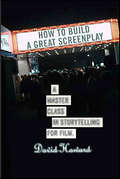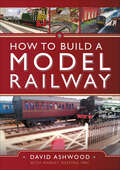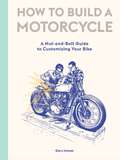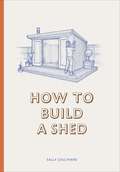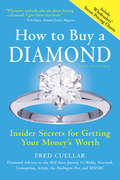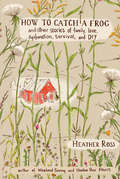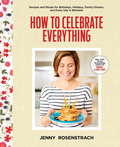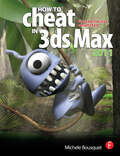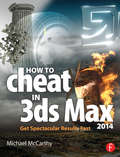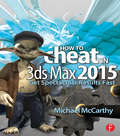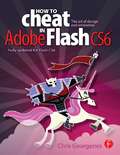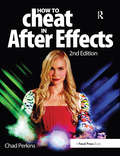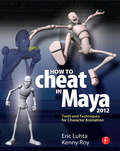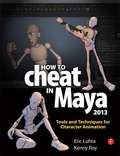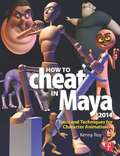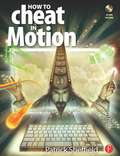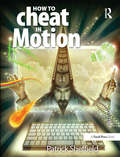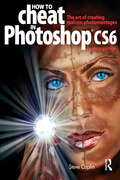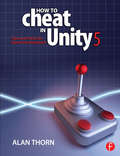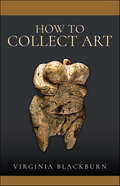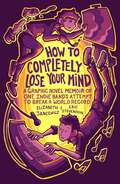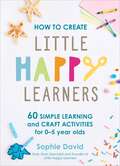- Table View
- List View
How to Build a Great Screenplay: A Master Class in Storytelling for Film
by David HowardHow to Bulid a Great Screenplay is a definitive guide on the mechanics of screenwriting--filled with examples--from the author of The Tools of Screenwriting. Acclaimed USC screenwriting teacher David Howard has guided hundreds of students to careers in writing for film and television. Drawing on decades of practical experience and savvy, How to Build a Great Screenplay deconstructs the craft of screenwriting and carefully reveals how to build a good story from the ground up. Howard eschews the "system" offered by other books, emphasizing that a great screenplay requires dozens of unique decisions by the author. He offers in-depth considerations of:* characterization * story arc * plotting and subplotting * dealing with coincidence in story plotting* classical vs. revolutionary screenplay structure * tone, style, and atmosphere * the use of time on screen* the creation of drama and tension * crucial moments in storytellingThroughout the book, Howard clarifies his lessons through examples from some of the most successful Hollywood and international script-oriented films, including Pulp Fiction, American Beauty, Trainspotting, North by Northwest, Chinatown, and others. The end result is what could very well become the classic text in the field---a bible for the burgeoning screenwriter.
How to Build a House with an Architect
by John M. BakerBuilding a house with an architect should be fun. The experience should be one of the most exciting and creative efforts in one's entire life. It can only be so, however, if the client and the architect enjoy that special rapport that comes from understanding how a house is designed and constructed.
How to Build a Model Railway
by David Ashwood Market DeepingMoving from a train set out of a box to making your own model railway can seem a daunting proposition. Whether you go your own way, wish to follow a prototype tightly or have an inherited stock that you want to make the best of. This book covers the act of deciding on a design that will keep the interest alive. Executing it in a manner that is within your skills set, and finishing it to a quality you are satisfied by within a time and financial limit. Here learning from those who have had both successes and the occasional false start will assist you in execution of your project and maintaining its interest. The book aims to explain jargon and includes such subjects as project design and planning, alternative baseboard construction methods, track laying, basic electrics accompanied by a rich and varied imagery. The Market Deeping Model railway club rose to public notice in May 2019 following the sad overnight vandalism of their annual railway show. The breaking news story became a worldwide cause célèbre bringing a whirlwind of kind support from modelers and the general public. The rebuilding of the club's damaged layouts and new projects for replacements gave the rare opportunity of experienced modelers to photograph and document the build process and revisit the basics. The results are incorporated into this book making a positive and cathartic activity from a distinctly negative situation.
How to Build a Motorcycle: A Nut-and-Bolt Guide to Customizing Your Bike
by Gary InmanHow to Build a Motorcycle leads you through all the key stages - from initially finding the right project for your skill level, to sourcing a base bike and safely taking on some full-on bike-building tasks. With clear, easy-to-follow instructions, proper advice and specially commissioned step-by-step illustrations throughout it is an ideal aid to getting your hands oily. Written by Gary Inman, the co-founder of independent motorcycle magazine Sideburn, and illustrated by Adi Gilbert who is best known for his bicycle and motorcycle drawings whose clients include Harley-Davidson, Guy Martin, Wired magazine, Sideburn magazine and Nike, this is a must-have for all motorcycle lovers.Read this book, even dip in and out where relevant. If it makes sense, schedule some time, clear your mind, pull on some old clothes, grab your toolbox and get going. The chapters in How to Build a Motorcycle will tell you how to complete a huge variety of tasks that will allow even the greenest of novices to get their hands dirty and start modifying with purpose. If you belong to this camp, start with some of the low-input, high-reward jobs, such as fitting bars, swapping the rear shocks or wiring in a new tail light. Even though these require relatively little work, they'll transform the look of your bike, and completing them will fill you with confidence to undertake the more difficult jobs, such as fitting more modern front forks or even making your own frame.The book comes with a glossy 32-page section on finished bikes and is a reference and the perfect gift for all fans, from those who merely like to tinker, to riders taking on a full build.
How to Build a Motorcycle: A Nut-and-Bolt Guide to Customizing Your Bike
by Gary InmanHow to Build a Motorcycle leads you through all the key stages - from initially finding the right project for your skill level, to sourcing a base bike and safely taking on some full-on bike-building tasks. With clear, easy-to-follow instructions, proper advice and specially commissioned step-by-step illustrations throughout it is an ideal aid to getting your hands oily. Written by Gary Inman, the co-founder of independent motorcycle magazine Sideburn, and illustrated by Adi Gilbert who is best known for his bicycle and motorcycle drawings whose clients include Harley-Davidson, Guy Martin, Wired magazine, Sideburn magazine and Nike, this is a must-have for all motorcycle lovers.Read this book, even dip in and out where relevant. If it makes sense, schedule some time, clear your mind, pull on some old clothes, grab your toolbox and get going. The chapters in How to Build a Motorcycle will tell you how to complete a huge variety of tasks that will allow even the greenest of novices to get their hands dirty and start modifying with purpose. If you belong to this camp, start with some of the low-input, high-reward jobs, such as fitting bars, swapping the rear shocks or wiring in a new tail light. Even though these require relatively little work, they'll transform the look of your bike, and completing them will fill you with confidence to undertake the more difficult jobs, such as fitting more modern front forks or even making your own frame.The book comes with a glossy 32-page section on finished bikes and is a reference and the perfect gift for all fans, from those who merely like to tinker, to riders taking on a full build.
How to Build a Shed
by Sally CoulthardEver dreamed of having your very own garden retreat? Off-the-shelf sheds aren’t always the answer - the cheap ones are badly made and freezing cold, and the better quality ones are really expensive. But what if you could build your own shed from scratch? How to Build a Shed is the ultimate practical guide. With its clear, easy-to-follow instructions, expert advice and specially commissioned illustrations, you'll be able to source the materials, choose the right tools and build your dream shed on a budget - even if you’ve never used a hammer.
How to Buy a Diamond: Insider Secrets for Getting Your Money's Worth
by Fred CuellarBuying a diamond can be one of the most important and intimidating purchases you ever make. Whether you're getting engaged or buying for an anniversary, investment or "just because," How to Buy a Diamond will take the pressure and uncertainty out of getting the best diamond for your money. Newly revised and updated, How to Buy a Diamond is the only book on the market to include wholesalers' secret pricing charts that you, the public, never get to see! The charts are broken down by carat, clarity, and color —including the various types of color within each color grade. This eighth edition includes: Matching your funds with the perfect diamond The four Cs explained: clarity, color, cut and carat size Ring styles and settings Grade bumping: what it is and how to spot it Picking the right jeweler Jewelers' tricks of the trade Wholesaler' secret pricing charts!Praise for How to Buy a Diamond:"Finally, one of the top diamond experts breaks the silence and demystifies the world of diamonds for regular folk like you and me." —Gregory J.P. Godek, author of 1001 Ways to Be Romantic "Whenever anybody asks me about buying a diamond, I give them this book." —Rob Bates, National Jeweler
How to Catch a Frog: And Other Stories of Family, Love, Dysfunction, Survival, and DIY
by Heather RossStories about growing up in a family of artists and idealists in Vermont, complete with illustrations and how-to instructions. Much of author and illustrator Heather Ross’s work has been inspired by her childhood spent in a rural corner of Vermont during the 1970s. Her upbringing was defined by stunning natural beauty, innovative living, and daily lessons in self-reliance—but also dysfunction, a self-imposed but nearly inescapable poverty, and little exposure to basic life skills. When, in her twenties, Ross complained to her mother about a long list of things she had missed out on and that had compromised her chance of ever leading a “normal” life, her mother waved a hand and replied, “Well, you should thank me, because you have a lot of good stories instead.” How to Catch a Frog is a collection of those stories, plus others that show Ross’s eventual route to success as an artist, entrepreneur, and mother. “A very honest coming-of-age tale . . . The book reminded me of the powerful memoir Wild by Cheryl Strayed, and if you loved that book, this one will rock your world as well.” —Meg Cox, quilt journalist, author, and instructor
How to Celebrate Everything: Recipes and Rituals for Birthdays, Holidays, Family Dinners, and Every Day In Between
by Jenny RosenstrachA warm and inviting guide to turning birthdays, holidays, and everyday occasions into cherished traditions, with more than 100 time-tested recipes--from the creator of the popular blog and book Dinner: A Love Story and author of the New York Times bestseller Dinner: The Playbook "Families crave rituals," says Jenny Rosenstrach, and by rituals she means not just the big celebrations--Valentine's Day dinners, Mother's Day brunches, Halloween send-offs, Thanksgiving feasts, holiday cocktail parties--but the little ones we may not even realize are rituals: a platter of deluxe nachos on Super Bowl Sunday, or a bowl of creamy mashed potatoes after every braces-tightening session. Whether simple or elaborate, daily or annual, these rituals all serve the same purpose for Rosenstrach: to bring comfort, connection, and meaning to every day. 100+ recipes, including: * popovers, apple fritters, and golden pancakes, perfect for sleepover mornings or birthday breakfasts * "Interfaith Sliders": one version with ham and another with brisket * Rosenstrach's legendary chocolate Mud Cake--plus an entire section on birthdays, including a one-size-fits-all party planner that does not rely on pizza * complete menus for Thanksgiving, Christmas, and New Year's Eve * and, of course, dozens of Rosenstrach's signature family dinners: Grilled Soy-Glazed Pork Chops, Harissa Roasted Chicken, Crispy Chickpeas with Yogurt Sauce and Naan, Grilled Spicy Shrimp Tacos with Avocado Butter and Summer Cabbage, and more In this digital, overscheduled age, How to Celebrate Everything helps families slow down, capture the moments that matter--and eat well while doing it.Advance praise for How to Celebrate Everything "I have been an ardent fan of Jenny Rosenstrach's beautiful writing for years. I always know that every word of her books will be something to savor, and How to Celebrate Everything will strike a chord with anyone who enjoys family, friends, and delicious food."--Ree Drummond, New York Times bestselling author of The Pioneer Woman CooksFrom the Hardcover edition.
How to Cheat in 3ds Max 2011: Get Spectacular Results Fast
by Michele Bousquet**How to Cheat in 3ds Max - updated for latest rev of Max**Need to get results with 3ds max fast? Why take months to learn every button in 3ds max when you can create great visuals with just a few key tools? Learn to create quick yet stunning special effects, and animated characters with the fastest techniques possible. Need convincing grass, trees, water, shadows? You can use the memory-hogging methods that choke your display and take forever to render, or you can get it done bing-bang with this book. When you need an animated character you can spend days fiddling with polygons, or you can use this book to put it together in minutes and get the entire project done in a day. How to Cheat in 3ds max includes a host of time-saving techniques as well as little-known tools that will make you look like an expert in no time flat. This book is for busy professionals who need to get it done right, but also need it done fast. This rev of the book will have higher-end cheats (for Intermediate users) and ALL NEW or UPDATED content on: new modelling and material tools, mental ray, special effects, particle systems, and scripting. The web site offers scene files and bitmaps used to illustrate the cheats, also music files, organizational samples, and instructional Camtasia movies of Michele where Michele showing some of the trickier techniques.
How to Cheat in 3ds Max 2014: Get Spectacular Results Fast
by Michael McCarthyWhy take months to learn every button in 3ds Max when you can create great visuals with just a few key tools? Utilize the tool of choice, 3ds Max 2014, for generating realistic environments, seamless CG effects, and jaw dropping games in a matter of hours. You can use the memory-hogging methods that choke your display and take forever to render, or you can get it done quickly and efficiently. Michael McCarthy offers a goldmine of artistic inspiration, timesaving tips & tricks, and step-by-step walkthroughs—you’ll wonder how you every got by without it! Start animating today with detailed tutorials, source files, bitmaps, and video demonstrations—all featured on the companion website. This new edition has been completely revamped for 3ds Max 2014. You will find coverage on brand new features and tools such as Scene Management, iRay, Nitrous, Mass FX, and particles and physics. How to Cheat in 3ds Max 2014 features interviews with industry professionals that will help you gain the edge you need in the competitive world of animation. 3ds Max luminary and recipient of the 2011 Autodesk 3ds Max Master Award, author Michael McCarthy shares his 3ds Max secrets and little-known tips and tricks that save users hours of time Includes all new content and advanced cheats on modelling, special effects, natural elements, and the particle system Proven How to Cheat series teaches how to create quick yet stunning special effects, animations, realistic textures, and game elements
How to Cheat in 3ds Max 2015: Get Spectacular Results Fast (How To Cheat)
by Michael McCarthyWhy take months to learn every button in 3ds Max when you can create great visuals with just a few key tools? Utilize the tool of choice, 3ds Max 2015, for generating realistic environments, seamless CG effects, and jaw dropping games in a matter of hours. You can use the memory-hogging methods that choke your display and take forever to render, or you can get it done quickly and efficiently. <P><P> Michael McCarthy offers a goldmine of artistic inspiration, timesaving tips & tricks, and step-by-step walkthroughs—you’ll wonder how you every got by without it! This new edition has been completely revamped for 3ds Max 2015. Start animating today with detailed tutorials, source files, bitmaps, and video demonstrations—all featured on the companion website.
How to Cheat in Adobe Flash CS6: The Art of Design and Animation
by Chris GeorgenesEditor's note, 1/15/2013: We have discovered an error with the Table of Contents and are currently working on correcting it. If you find an error in your book, please visit the companion site http://www.focalpress.com/books/details/9780240522500/ for the correct version. Whether you are creating an animated short, catchy and fun cartoon or mobile game, save time and money with expert cheats by renowned Flash Expert, Chris Georgenes with all new content for the Flash CS6 revision. With practical applications and step by step tutorials solve problems quickly to develop creative projects to time and to budget. Many of these walkthroughs are real-world client projects, with the source files supplied for you to open and explore. With these real-life professional projects you'll discover how to: bring objects to life with cool motion effects, make it rain, snow or set your world ablaze, develop flash mobile applications and many more tips and tricks not found anywhere else! With his in-depth knowledge of the little-known secrets used by the pros to produce creative, professional animations, Chris is the go-to guru for designers and animators who want to create great animation, applications or motion design with Flash. Fully updated for CS6, How to Cheat in Flash CS6, is a goldmine of artistic inspiration, timesaving practical tips, tricks and step-by-step walkthroughs that you'll wonder how you survived without it. New! CS6 cheats and examples with practical solutions for the busy animator with a focus on Action Script, Flash for mobile applications, specifically for Android development, as well as a focus on an improved physics engine. Put the Adobe Flash CS6 cheats to the test with the fully updated companion website with downloadable Flash source files, examples and video tutorials, and a creative commons game, developed with Adobe, to demonstrate the new functionality of CS6!
How to Cheat in After Effects (How To Cheat In Ser.)
by Chad PerkinsGet the most from the most widely used application in the postproduction field! Gain the insider tips you need to compose eye-catching, imaginative Adobe After Effects projects quickly and effectively. In How to Cheat in After Effects, Second Edition seasoned AE expert Chad Perkins provides dozens of concise, step-by-step tutorials and lavish 4-color illustrations to get you on the fast track to producing amazing motion graphics and visual effects. Updated for CS6, this new edition has been revised to include: A brand new chapter on the most popular 3rd party effects including Trapcode Particular and Video Copilot's Element 3D New cheats on professional compositing, expressions, and high end visual effects Tons of cool light tricks and lessons on how to use Video Copilot's Optical Flares A thorough explanation of the Ray-trace 3D engine introduced in After Effects CS6 An all new companion DVD with project files allowing you to work alongside the exercises in the book, as well as QuickTime movies displaying techniques There’s no time to waste! Whether you are an intermediate After Effects user in need of its more advanced tools or a novice looking for techniques to up your game, this book will bring your motion graphics, visual effects, and graphic compositions to the next level. For customers who buy an electronic version of the book, all the DVD project files are available for download at www.focalpress.com/9780415661065
How to Cheat in Maya 2012: Tools and Techniques for Character Animation
by Eric LuhtaThe Maya guide for animators, How to Cheat in Maya 2012 presents everything you need to know about character animation in Maya. Fully updated for the latest revision of Maya, this book provides you with complete, step-by-step walkthroughs of essential animation techniques to increase your efficiency and speed. This is an animator's workflow in book form, written by professional animators-not a software book with a few animation pointers thrown in. In addition to all the gold-mine coverage and interviews with expert animators from the previous edition, How to Cheat in Maya 2012 also features a new in-depth chapter on the principles of animation, updated information on camera settings and animation using Maya's new Camera Sequencer tool, the ins and outs of the brand new Editable Motion Trails tool, new techniques for working with characters in multi-shot animation tests and short films, a new cycles chapter covering actions like flying and walks, time-saving scripts, and advanced tricks with the new Graph Editor. The proven "How to Cheat" series gets you up to speed quickly, and in a way that's fun.
How to Cheat in Maya 2013: Tools and Techniques for Character Animation
by Kenny Roy Eric LuhtaAll professional animators know a handful of secrets that give them an edge in a production environment. "How to Cheat in Maya" puts these secrets in your hands! Learn time and energy saving techniques tested in real Hollywood productions in this book, jam-packed with screenshots and scene files designed to get you up to speed quickly. From menus to modeling, lipsync to lighting, How to Cheat in Maya 2013 covers all of the methods available in the latest version of Maya. Get up to speed quickly and produce stellar results with these insider workflows. With new, updated cheats for the latest version of Maya, "How to Cheat in Maya" is an essential guide for amateur and professional 3D animators alike. Fulyl updated with gold-mine coverage including: expanded sections on production workflow, all new chapters covering rigging cheats and Maya's referencing tools, and brand new project files demonstrating production-proven techniques. The companion website includes complete scene files for exercises and techniques, extra rigs, Quicktime movies of full projects, and video tutorials.
How to Cheat in Maya 2014: Tools and Techniques for Character Animation
by Kenny RoyAll professional animators know a handful of secrets that give them an edge in a production environment. "How to Cheat in Maya" puts these secrets in your hands! Learn time and energy-saving techniques tested in real Hollywood productions in this book, jam-packed with screenshots and scene files designed to get you up to speed quickly. <P><P>From menus to modeling, lipsync to lighting, How to Cheat in Maya 2014 covers all of the methods available in the latest version of Maya. Get up to speed quickly and produce stellar results with these insider workflows. With new, updated cheats for the latest version of Maya, How to Cheat in Maya 2014 is an essential guide for amateur and professional 3D animators alike. Fully updated with gold-mine coverage including: expanded sections on production workflow, all new chapters covering rigging cheats and Maya's referencing tools, and brand new project files demonstrating production-proven techniques. <P><P>The companion website includes complete scene files for exercises and techniques, extra rigs, Quicktime movies of full projects, and video tutorials.
How to Cheat in Motion
by Patrick SheffieldThe text provides a "cookbook" style of learning computer animation, presenting the user with specific recipes to achieve desirable outcomes. This practical guide helps readers to enhance titles, motion graphics and visual effects with Motion. Step-by-step instruction is concisely described and lavishly illustrated.
How to Cheat in Motion
by Patrick SheffieldCreative solutions without the filler. That is what you get from this practical guide to enhancing your titles, motion graphics and visual effects with Motion. Step-by-step instruction is concisely described and lavishly illustrated. The downloadable resources show the techniques at work so you can take them and run.
How to Cheat in Photoshop CS6: The art of creating realistic photomontages
by Steve CaplinWith enough charm and wit to make learning Photoshop anything but taxing, Steve Caplin delivers the next instalment of the How to Cheat series, containing all the techniques you need to create and master the art of photomontage. Delivered in easy to follow step-by-step tutorials How to Cheat in Photoshop covers all the basics of selections and layers before moving onto top tricks and techniques for creating realistic works of art for business, pleasure, or something in between. An accompanying DVD is packed full of practice images and tutorial movies for you to working along with, plus bonus chapters to push your skills even further. Using a tweaked design that is clearer and fresher than previous editions this is the funnest way to master Photomontage.
How to Cheat in Unity 5: Tips and Tricks for Game Development
by Alan ThornLooking to become more efficient using Unity? <P><P>How to Cheat in Unity 5 takes a no-nonsense approach to help you achieve fast and effective results with Unity 5. Geared towards the intermediate user, HTC in Unity 5 provides content beyond what an introductory book offers, and allows you to work more quickly and powerfully in Unity. Packed full with easy-to-follow methods to get the most from Unity, this book explores time-saving features for interface customization and scene management, along with productivity-enhancing ways to work with rendering and optimization. In addition, this book features a companion website at www.alanthorn.net, where you can download the book’s companion files and also watch bonus tutorial video content. <P><P>Learn bite-sized tips and tricks for effective Unity workflows <P><P>Become a more powerful Unity user through interface customization <P><P>Enhance your productivity with rendering tricks, better scene organization and more <P><P>Better understand Unity asset and import workflows <P><P>Learn techniques to save you time and money during development
How to Collect Art
by Virginia BlackburnA comprehensive and up-to-date guide to collecting across the board, from grand Old Masters to humble kitchenalia. People have always made art and people have always collected art. But it is only recently that collecting became possible for everyone, not just the very rich. Indeed, collecting has never been more popular, as the rise of art fairs, antique fairs, television programs devoted to finding treasures in your attic and much more attests. And not only is collecting fun, it could be potentially very profitable, too. But where to start? These days everything is collectable, from Old Masters to 1950s kitchenalia and it can be bewildering when you start out. And not just when you start out. Even experienced collectors need some help and guidance and How To Collect Art provides exactly this. Author and collecting expert Virginia Blackburn takes you through everything you need to know, tackling not only mainstream fields such as paintings, furniture, china and statuary, but through antiquities, modern sculpture, Sailors’ Valentines, street art, and much more. This is a comprehensive look at many and varied fields of collecting, for amateur and professional alike. Virginia also explains how to educate yourself in your chosen field, and where to go to find the art you buy, covering galleries, auctions, degree shows and more. She explains how, when and where to bargain, looks at ways of displaying your collection and helps you get into the mindset of a collector. Art may be for art’s sake, but it provides the rest of us with a lot of pleasure too.
How to Completely Lose Your Mind: A Graphic Novel Memoir of One Indie Band's Attempt to Break a World Record
by Eric Stevenson Elizabeth JancewiczAn Indie Band’s Record-Breaking Music Tour: A Graphic Novel“As a touring musician, I absolutely adored this heartfelt, honest, and beautifully illustrated account of the unique pitfalls and victories of DIY touring.” ―Tommy Siegel, cartoonist and guitarist/singer in Jukebox the Ghost#1 New Release in Biographies and History Graphic NovelsFrom the indie band Pocket Vinyl and the artists behind the documentary Drive. Play. Sleep. and the popular webcomic The Touring Test, this hilarious artists’ graphic novel memoir chronicles a couple’s road trip across the USA as they break a world record.A world record smashing music tour through 50 States in 45 Days. Together, Eric Stevenson and Elizabeth Jancewicz perform as the band Pocket Vinyl, where Eric slams on the piano and sings while Elizabeth creates a large oil painting on stage. In these artists’ graphic novel, watch as they take on their biggest challenge yet: to tour the whole nation in just 45 days, breaking the record for the fastest time a band has played in all 50 U.S. states.A wild road trip of performance highs, self-doubt lows, and determination. As co-author Elizabeth Janceqicz says, “I knew that embarking on such a monstrous adventure would provide me with stories to tell, but I hadn't realized how much those stories would change me... In retrospect, we learned so much: about how our art helps people, how interconnected we all are, and how easily our minds can descend into mental illness without us even realizing it’s happening.”Inside find:A breakneck road trip through the local music scenes across America An unforgettable story of what life is like behind the scenes on an indie band’s record-breaking tourA graphic novel on mental health, humor, the love of music and art, and the gifts of human kindnessIf you liked It's Lonely at the Centre of the Earth, Marbles, or Can't We Talk about Something More Pleasant? you'll love How to Completely Lose Your Mind.
How to Cook Like a Top Chef
by Bravo MediaRecipes, techniques, photos, and interviews from Bravo’s hit show!The best food show on cable TV presents the ultimate guide to becoming a Top Chef. This combination cookbook and culinary primer features recipes from the show (and from season one of Top Chef: Masters), along with insider techniques from favorite contestants and judges.Covering everything from knife skills to sauces and sous-vide, How to Cook Like a Top Chef teaches aspiring chefs what it takes to be a star in the kitchen. Packed with exclusive content, including a foreword by Top Chef: Masters winner Rick Bayless, original recipes from contestants, behind-the-scenes interviews, juicy trivia, and tons of tips and tricks, this volume is indispensable on the cook’s countertop and essential reading for Top Chef fans.
How to Create Little Happy Learners: 60 simple learning and craft activities for 0-5 year olds
by Sophie DavidHow to Create Little Happy Learners presents an inspiring selection of learning and craft activities designed to promote a love of learning. Written by Sophie David, a former early years teacher and adviser who is now a stay-at-home mum with 3 children under 5, she is now channelling her knowledge and creativity to show-case the craft ideas she was using to keep her children entertained. Here, she offers over 60 fun-packed activities for children, all highlighting different skills (fine motor, phonics, maths, creativity, communication and independence). Split into topics ranging from animals to transport, Sophie not only offers crafting activities that involve children and can be used time and time again utilising everyday items, she also adapts each activity for different age groups (from 0-5 years) so you can reuse the book as your child grows.Some activities include:- Searching for animal fossils (phonics and creativity)- Bug Count (problem solving and maths)- Emotion stones (communication)- Creating sensory bags (baby play and motor skills)This book offers a bank of great activities to not only inspire a love of learning in your children but to make that journey a fun, craft filled one.
